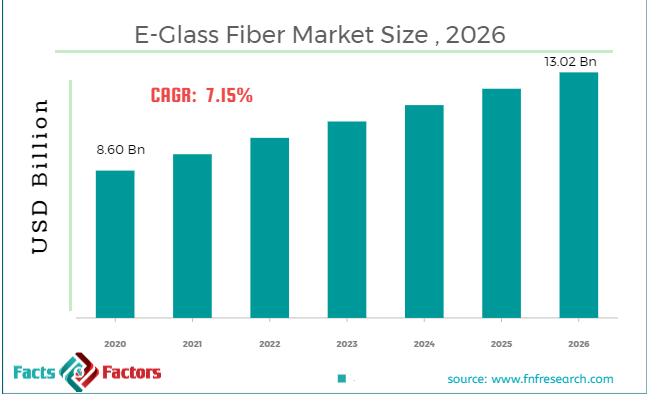Search Market Research Report
E-Glass Fiber Market Size, Share Global Analysis Report, ber Market By Types (General-Purpose Glass Fiber & Special-Purpose Glass Fiber), By Application (Construction, Transportation, Industrial, Consumer, & Wind), and By Regions - Global Industry Perspective, Comprehensive Analysis, and Forecast, 2021 – 2026

E-Glass Fiber Market By Types (General-Purpose Glass Fiber & Special-Purpose Glass Fiber), By Application (Construction, Transportation, Industrial, Consumer, & Wind), and By Regions - Global Industry Perspective, Comprehensive Analysis, and Forecast, 2021 – 2026
Industry Insights
[216+ Pages Report] As per the latest research and survey report issued by Facts and Factors, the global e-glass fiber market was valued at around USD 8.60 Billion in 2020 and is expected to register revenues worth USD 13.02 Billion by the end of 2026, growing at an exceptional CAGR of approximately 7.15% between 2021 and 2026.

 Market Overview
Market Overview
E-glass fiber is an industrial material that can be produced easily from raw materials. It is a versatile version of glass fiber. This glass fiber possesses properties such as chemical attack resistance, transparency, hardness, and stability. The demand for e-glass fibers is increasing basically due to its properties such as flexibility, stiffness, and strength. The e-glass fibers are used in the production of various special-purpose products, structural composites, and printed circuit boards. It is a version of glass fiber that can provide excellent insulation for electric wires and other electrical conduits. These excellent properties have increased the use of e-glass fiber in the production of different types of fiberglass. The intricately woven fibers of glass make it better than fibers such as polymer and carbon fiber.
Glass Fiber Market

 Industry Growth Factors
Industry Growth Factors
Advancements in research and technology and continuous up-gradation of the previous iteration of e-glass fiber will drive the market during the forecast years. A wide range of applications is dependent on e-glass fiber. Additionally, when compared to glass and silk fibers, e-glass fibers fares the best at an optimal price. The defense and aerospace industry has a tremendous applicable components which has given a rise to government funding and incentive for the market. Furthermore, advent of an increase in wind energy plants and swift change from traditional to alternative energy sources will further drive the market of global e-glass fiber to a lucrative market during the forecast period. High initial cost and intricate manufacturing processes will hamper the growth of the market to a certain extent.
Growing need for high-performance fiber glass and technological advancements for the production of lightweight material for automotive parts’ production is projected to drive the global e-glass fiber market. Furthermore, it is also widely used as additives in building & construction, aerospace, marine, wind energy, automotive & transport, pipes & tanks, and other industrial sectors owing to its cost effectiveness, lightweight products, and superior durability. The research carried out in the area of thermal insulation of e-glass fiber helps open new funding opportunities for the market.
 Segmentation Analysis
Segmentation Analysis
The global e-fiber glass market can be segmented on the basis of types, applications, and regions.
The global e-glass fiber market can be divided into general-purpose glass fiber and special-purpose glass fiber on the basis of types. The global e-glass fiber can be broken down into construction, transportation, industrial, consumer, and wind on the basis of applications.
 Report Scope
Report Scope
Report Attribute |
Details |
Market Size in 2020 |
USD 8.60 Billion |
Projected Market Size in 2026 |
USD 13.02 Billion |
CAGR Growth Rate |
7.15% CAGR |
Base Year |
2020 |
Forecast Years |
2021-2026 |
Key Market Players |
Taishan Fiberglass, Changzhou Tianma Group, Jushi Group, Owens Corning Corporation, Nippon Electric Glass, Vetrotex, Lanxess, Johns Manville, Sichuan Weibo New Material Group, Ahlstrom, and PPG Industries, among others. |
Key Segment |
By Types, Application, and Region |
Major Regions Covered |
North America, Europe, Asia Pacific, Latin America, and the Middle East & Africa |
Purchase Options |
Request customized purchase options to meet your research needs. Explore purchase options |
 Regional Analysis
Regional Analysis
The region of North America is expected to witness the market share during the forecast period. The extensively developed aerospace and defense sector in the region alongside a well-funded government program for further research and development will drive the growth of the market in the region.
 Competitive Players
Competitive Players
The global participants in the global e-fiber glass market are :
- Taishan Fiberglass
- Changzhou Tianma Group
- Jushi Group
- Owens Corning Corporation
- Nippon Electric Glass
- Vetrotex, Lanxess
- Johns Manville
- Sichuan Weibo New Material Group
- Ahlstrom
- PPG Industries
- among others
 By Type Segment Analysis.
By Type Segment Analysis.
- General-Purpose Glass Fiber
- Special-Purpose Glass Fiber
 By Application Segment Analysis
By Application Segment Analysis
- Construction
- Transportation
- Industrial
- Consumer
- Wind
 By Regional Segment Analysis
By Regional Segment Analysis
- North America
- U.S.
- Canada
- Europe
- UK
- France
- Germany
- Italy
- Spain
- Rest of Europe
- Asia Pacific
- China
- Japan
- India
- South Korea
- Southeast Asia
- Rest of Asia Pacific
- Latin America
- Brazil
- Mexico
- Rest of Latin America
- Middle East and Africa
- GCC Countries
- South Africa
- Rest of MEA
Industry Major Market Players
- Taishan Fiberglass
- Changzhou Tianma Group
- Jushi Group
- Owens Corning Corporation
- Nippon Electric Glass

Copyright © 2024 - 2025, All Rights Reserved, Facts and Factors


